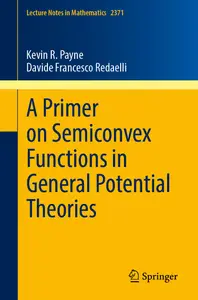A Primer on Semiconvex Functions in General Potential Theories
English | 2025 | ISBN: 9783031943409 | 125 pages | PDF | 2.44 MB
This book examines the symbiotic interplay between fully nonlinear elliptic partial differential equations and general potential theories of second order. Starting with a self-contained presentation of the classical theory of first and second order differentiability properties of convex functions, it collects a wealth of results on how to treat second order differentiability in a pointwise manner for merely semicontinuous functions. The exposition features an analysis of upper contact jets for semiconvex functions, a proof of the equivalence of two crucial, independently developed lemmas of Jensen (on the viscosity theory of PDEs) and Slodkowski (on pluripotential theory), and a detailed description of the semiconvex approximation of upper semicontinuous functions.
The foundations of general potential theories are covered, with a review of monotonicity and duality, and the basic tools in the viscosity theory of generalized subharmonics, culminating in an account of the monotonicity-duality method for proving comparison principles. The final section shows that the notion of semiconvexity extends naturally to manifolds. A complete treatment of important background results, such as Alexandrov’s theorem and a Lipschitz version of Sard’s lemma, is provided in two appendices.
The book is aimed at a wide audience, including professional mathematicians working in fully nonlinear PDEs, as well as master’s and doctoral students with an interest in mathematical analysis.



